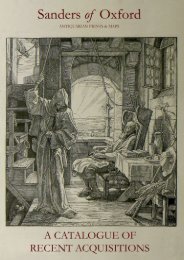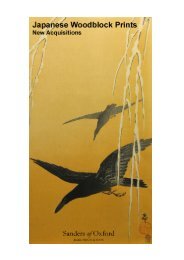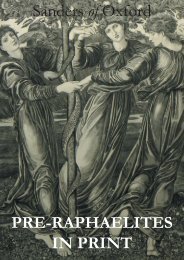«Heading» - International League of Antiquarian Booksellers
«Heading» - International League of Antiquarian Booksellers
«Heading» - International League of Antiquarian Booksellers
Create successful ePaper yourself
Turn your PDF publications into a flip-book with our unique Google optimized e-Paper software.
cosmographers and geographers <strong>of</strong> the 16th century, as<br />
well as an accomplished scientific instrument maker. He<br />
is most famous for introducing Mercators Projection, a<br />
system which allowed navigators to plot the same<br />
constant compass bearing on a flat map.<br />
Johann Baptist Homann was a German cartographer<br />
who set up his own publishing company in 1702. It was<br />
the most successful map publishing company <strong>of</strong> the<br />
18th century. After publishing his first atlas in 1707 he<br />
became a member <strong>of</strong> the Berlin Academy <strong>of</strong> Sciences.<br />
In 1715 Homann was appointed to be Imperial<br />
Geographer <strong>of</strong> the Holy Roman Empire.<br />
His first maps were published in 1537 (Palestine), and<br />
1538 (a map <strong>of</strong> the world), although his main<br />
occupation at this time was globe-making. He later<br />
moved to Duisburg, in Germany, where he produced his<br />
outstanding wall maps <strong>of</strong> Europe and <strong>of</strong> Britain. In 1569<br />
he published his masterpiece, the twenty-one-sheet map<br />
<strong>of</strong> the world, constructed on Mercator's projection. His<br />
Atlas, sive Cosmographicae Meditationes de Fabrica<br />
Mundi, was completed by his son Rumold and<br />
published in 1595. After Rumold's death in 1599, the<br />
plates for the atlas were published by Gerard Jr.<br />
Following his death in 1604, the printing stock was<br />
bought at auction by Jodocus Hondius, and re-issued<br />
well into the seventeenth century.<br />
[27763]<br />
£800<br />
Condition: Light discolouration to centre fold.<br />
[27563]<br />
£750<br />
Asia & Middle East<br />
168. Tartaria<br />
Copper engraved with hand colour<br />
Mercator, Gerard & Hondius, Jodocus<br />
Amsterdam, c.1633<br />
337 x 488 mm<br />
framed<br />
English Text on verso.<br />
Published in Hondius' editions <strong>of</strong> the Mercator Atlas<br />
from 1606 onwards, showing China, Korea and the<br />
northern Pacific coast <strong>of</strong> America showing the two<br />
continents separated by the Straits <strong>of</strong> Anian<br />
169. L’Empire de la Chine dressé d’après les Cartes de<br />
l’Atlas Chinois. Par le Sr. Robert de Vaugondy,<br />
Geographe ordinaire du Roi. Avec Privilege. 1751.<br />
Copper engraved with hand colour<br />
Vaugondy, Robert de<br />
Paris 1751<br />
483 x 525 mm<br />
unmounted<br />
From De Vaugondy's Atlas Universel, one <strong>of</strong> the most<br />
important atlases <strong>of</strong> the eighteenth-century, and<br />
published in 1757. The older material was revised with<br />
the addition <strong>of</strong> many new place names. In 1760, Robert<br />
de Vaugondy was appointed geographer to Louis XV.<br />
Condition: centre fold as issued<br />
[27279]<br />
£500<br />
Gerard Mercator (1512 - 1594) originally a student <strong>of</strong><br />
philosophy was one <strong>of</strong> the most renowned












